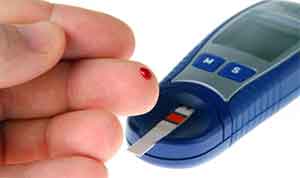Type 1 diabetes associated with increased risk of some cancer types
 New research reveals that type 1 diabetes is associated with an increased risk of various cancer types including cancers of the stomach, liver, pancreas, endometrium, ovary and kidney, but a reduced risk of other cancer types, including prostate and breast cancer. The results derive from a multicentre study of data from five countries, published in Diabetologia (the journal of the European Association for the Study of Diabetes [EASD]) by Senior Statistician Bendix Carstensen, Steno Diabetes Center, Denmark, Dr Stephanie Read and Professor Sarah Wild, University of Edinburgh, UK, and fellow members of the EASD Cancer and Diabetes group.
New research reveals that type 1 diabetes is associated with an increased risk of various cancer types including cancers of the stomach, liver, pancreas, endometrium, ovary and kidney, but a reduced risk of other cancer types, including prostate and breast cancer. The results derive from a multicentre study of data from five countries, published in Diabetologia (the journal of the European Association for the Study of Diabetes [EASD]) by Senior Statistician Bendix Carstensen, Steno Diabetes Center, Denmark, Dr Stephanie Read and Professor Sarah Wild, University of Edinburgh, UK, and fellow members of the EASD Cancer and Diabetes group.
Previous studies have shown that people with diabetes have an approximately 20-25% increased cancer incidence compared to people without diabetes; however, most of these findings have been based on people with type 2 diabetes, since they make up most (around 90%) of all people with diabetes. In this study, the authors explored the increased risk of various cancers associated specifically with type 1 diabetes.
The study analysed more than 9,000 cancer cases in type 1 diabetes patients diagnosed across five countries, using data from five nationwide diabetes registers: Australia (2000-2008), Denmark (1995-2014), Finland (1972-2012), Scotland (1995-2012) and Sweden (1987-2012). By linking these data with those in national cancer registries, the authors were able to compare the cancer incidence among people with type 1 diabetes to that of the general population.
The analyses across all cancers combined revealed no increased overall cancer risk among men with type 1 diabetes, whereas women with type 1 diabetes experienced a 7% increased overall cancer risk. The neutral overall cancer risk among men with type 1 diabetes was largely due to a 44% decreased incidence of prostate cancer – the most common non-skin cancer among men. When the authors excluded data for sex-specific cancer types (prostate, testis, breast, cervix, endometrium and ovary), excess cancer risk appeared in both men and women with type 1 diabetes (15% for men and 17% for women).
For specific cancer sites among people with type 1 diabetes, the study revealed increased risks of cancers of the stomach (23% for men, 78% for women); liver (two-fold among men, 55% for women); pancreas (53% for men, 25% for women), endometrium (42%) and kidney (30% for men, 47% for women). Conversely, women with type 1 diabetes were 10% less likely to have a diagnosis of breast cancer, although the reasons for this are unclear.
The study also reported that cancer incidence was highest shortly after diagnosis of diabetes. Cancer incidence was substantially higher among both men (2.3 times increased risk) and women (2.3 times) with type 1 diabetes during the first year of follow-up compared with longer follow-up. Cancer incidence subsequently declined to the level of the general population after approximately 20 years of having type 1 diabetes among men, but after only five years of having type 1 diabetes among women. The authors emphasise that the highly elevated cancer incidence soon after type 1 diabetes diagnosis is plausibly due to the detection of pre-existing cancers shortly after the diabetes diagnosis (when patients are receiving increased medical attention), rather than any association with the type 1 diabetes disease.
The authors state that their finding of a smaller excess in cancer incidence among persons with type 1 diabetes than in previous reports of persons with type 2 diabetes argues against a contribution of insulin treatment to the elevated incidence of cancer among persons with diabetes. If insulin treatment was a major cancer risk factor, the excess cancer incidence among people with type 1 diabetes would be expected to be higher than among people with type 2 diabetes, since all people with type 1 diabetes are treated with insulin whereas a substantially smaller proportion of people with type 2 diabetes receive insulin treatment. The authors suggest that their findings of an increased cancer risk among persons with diabetes may be due to a common mechanism such as elevated blood sugar levels occurring among both type 1 and type 2 diabetes patients.
The authors state: “On average, type 1 diabetes confers an excess incidence of several cancers. In particular, persons with type 1 diabetes had higher incidence of cancer of the liver, pancreas, kidney, endometrium and ovary and a lower incidence of prostate cancer than people in the general population. However, as for type 2 diabetes, increased risk of cancer was highest at the time of diabetes diagnosis and declined over time.”
They conclude: “Our findings do not support changes in policy for cancer screening for persons with type 1 diabetes. Recommendations for lifestyle approaches to reducing cancer risk such as avoiding smoking, weight management and physical activity apply to persons with type 1 diabetes as for the general population.”

